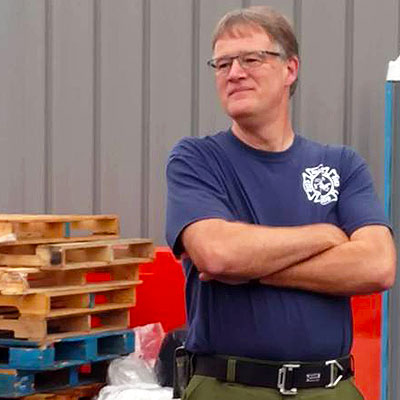
When the urgent call came in September for Steve Builta to travel to Oregon to train National Guard members in fighting wildfires, there was little time to decide.
Yet for the director of Technology Innovation and Learning Services for the NIU College of Education, the answer came quickly.
Two days later, Builta was on a plane flying to the Pacific Northwest.
“Oregon had a terrible fire situation this year. They had need to train 250 additional National Guard troops, but they didn’t have enough people to do the training,” he says. “The State of Oregon contacted the Illinois Fire Service Institute, and the program director called me.”
Builta, who is also the longtime chief of the volunteer fire department in Hillcrest, Ill., has been on the staff of the Illinois Fire Service Institute for 12 years. He and his colleagues there provide training for mostly volunteer fire crews around the state of Illinois in fighting wildland blazes and prescribed burns.
Funding comes from a Department of Natural Resources grant, which finances the training and supplies free gear to first responders who service populations of less than 10,000. “We provide them with the training and protective equipment to fight this type of fire safely,” he says, “and that makes huge difference.”
 In Oregon, the trainers from the Land of Lincoln joined trainers from across the country to deliver the 40-hour curriculum over only four long days. The courses are conducted under the National Wildfire Coordinating Group’s program, policies and standards for training.
In Oregon, the trainers from the Land of Lincoln joined trainers from across the country to deliver the 40-hour curriculum over only four long days. The courses are conducted under the National Wildfire Coordinating Group’s program, policies and standards for training.
Courses cover only the ground battles, which are waged with everything from shovels, rakes and hoes and “flappers” – mud flaps attached to long poles – to backpack water sprayers that “look like big Super Soakers.” Airborne wildfire fighting is not included.
Lessons in Oregon began with a class on fire behavior that focused on how weather, topography and fuel all can drive fire.
Remaining days were spent in the classroom during the morning, where the troops learned about preparation for firefighting, and in the field during the afternoon.
“There were two-and-a-half hours for skills stations; then the staff would put on a burn for the students,” Builta says. “The staff light the burn and suppress it; the class lead instructors talk to the students about fire behavior, what was going on, why we were doing what we were doing. After the fire was out, students would mop up and grid to make sure there were no hot spots left.”
 A fortunate change in the weather during the training gave the upper hand to the crews already on the job, he adds. As a result, only half of the 250 National Guard members were dispatched after their four-day prep.
A fortunate change in the weather during the training gave the upper hand to the crews already on the job, he adds. As a result, only half of the 250 National Guard members were dispatched after their four-day prep.
“This was the largest group of National Guard that I’d been around, and you just cannot say enough good things about them, their work ethic and their commitment to go out and do good things for the community,” Builta says.
He also is grateful for the cooperation of the Oregon Department of Public Safety Standards and Training and the Oregon Department of Forestry. They join similar agencies from Georgia, Montana and California who have received assistance from trained Illinois Fire Service Institute staff members.
California’s devastating wildfires this fall are the result of “two major problems,” Builta says.
“From what I have read, the spring was really wet in California. The grasses grow a lot, and give you a lot of fuels for fire. Then, they didn’t get a lot of rain, the grasses dried and made for lots of fuel on the ground,” he says.
Meanwhile, he adds, “the Santa Ana winds – when high pressure pushes air over the tops of the mountains – come down warm and dry with low humidity. If something catches fire, then a lot of dry winds coming down just ignite the fire.”

Although Builta is frequent trainer of wildland firefighters, teaching those courses across Illinois between five and 10 weekends each year, he rarely can accept the two-week standard deployments to battle the blazes. “With my job, it’s hard to do that,” he says.
However, fighting fires is an important part of his life at home – and one that involves the whole family.
Builta’s wife, Joelle; their son, Christopher; their daughter, Danielle Kaecker; and her husband, Justin, all are members of the Hillcrest Fire Department. Christopher recently returned from Montana, where he was dispatched to help fight the wildland fires there.
The story began 21 years ago when the Builtas bought their home in Hillcrest, located just north of Rochelle along Route 251.
 Joelle, pregnant with Christopher, was on doctor-ordered bedrest. Steve was unpacking boxes. As a powerful thunderstorm rumbled through town, a violent lightning strike rattled the house.
Joelle, pregnant with Christopher, was on doctor-ordered bedrest. Steve was unpacking boxes. As a powerful thunderstorm rumbled through town, a violent lightning strike rattled the house.
“Moments later, we could smell smoke,” Builta says, “so we called the volunteer fire department, and out they came.”
No fire was found, but the assistant chief believed he had found something: a new recruit. After his first invitation that day, he made a few more trips to the Builta home until the new guy in town finally said “yes.”
“My wife and I had talked about trying to become involved in the community,” Builta says. “I just had no idea this would be it.”

